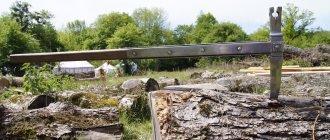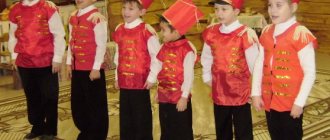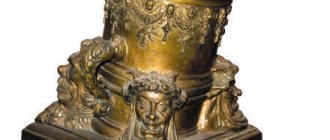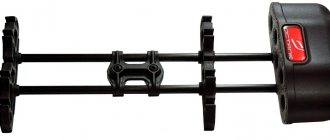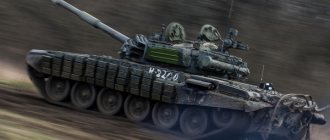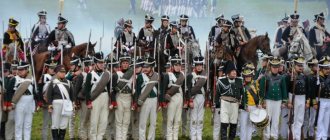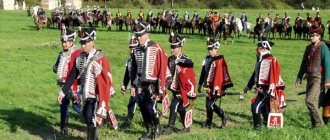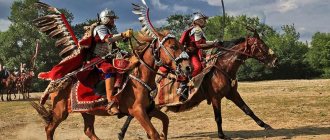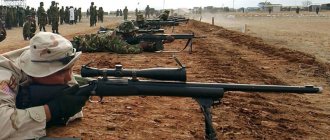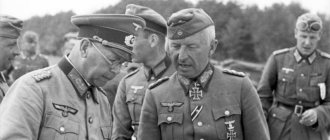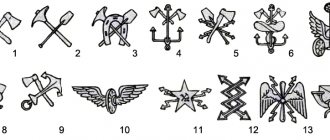There are many poems and songs written about the hussars, which over time became an integral part of army folklore for an entire era. Russian hussars, whose military exploits are covered in legends, rightfully occupy one of the leading places in the heroic chronicle of the Russian army. And although this type of light cavalry did not appear in Russia, it is difficult to imagine the Russian army today without hussar regiments. The peak of the glory of the hussar army was the Patriotic War of 1812.
Borodino
The birth of a new type of light cavalry
The word hussar came into the Russian language from Austria. It was here that this type of light cavalry developed, transforming from mounted militia units into regular military units. The actions of Polish light cavalry and Hungarian troops on the battlefields in Central and Eastern Europe showed the high efficiency of the new type of cavalry. Polish hussars, armed with light weapons, had mobility and could perform various combat missions. Flying detachments operated successfully during reconnaissance operations and caused considerable damage to enemy communications. When skillfully used as part of the main forces, the hussars showed themselves to be excellent shock units. An avalanche of light cavalry was able to cause confusion in the ranks of the infantry, disrupting the enemy's battle formations. They said about the hussars: “They are fast, swift and fearless. Their attack is always like a bolt from the blue.”
Serbian hussars
Courage, fearlessness and high military skill were the hallmarks of the hussar detachments. The peculiarities and specifics of military service left their mark on the future fate of the light cavalry. Hussar units will be formed according to a new principle. In a way, the hussars became the army special forces of that time. A whole caste of military personnel was formed, with its own rules, unspoken laws and principles. Being a hussar was considered honorable and prestigious. This was facilitated by the lifestyle of cavalrymen and the specifics of military service.
It is worth recalling that hussars were in the Russian army even under Tsar Mikhail Fedorovich. In the service of the Russian Tsar were mercenaries from Europe, united in three hussar companies. Peter I abolished the hussar units for some time, but already in 1723, hussar cavalry irregular formations again appeared in the Russian army. Attempts to turn irregular cavalry into full-fledged combat units were made by Field Marshal Munnich, but this idea did not bring success. Only under Catherine II were the first regular hussar regiments formed, recruited from among Russian citizens. Emperor Paul I played an active role in increasing the combat effectiveness of light cavalry. All hussar regiments in Russia were named after their place of permanent deployment. The flying cavalry began to regularly participate in military campaigns of the Russian army, becoming a full-fledged combat instrument of the modern army.
Equipment
You don't know what a hussar's cape is? It is usually called a mentik. The uniform of the hussars changed slightly over the course of the century, but retained its characteristics. It consisted of the following things: chakchirs, dolman, shako, mentik, boots, hussar sash, tashka. This also includes a saddle pad, one of the components of horse gear. By the way, each regiment had its own colors of hussar uniforms.
Hussar costume as an element of the cult of the brave warrior
The hussar could be recognized from afar. The cavalrymen were distinguished by a brilliant uniform, a special style in appearance and behavior. The Eastern European flavor contributed to the formation of the appearance of the gallant hussar. In the military hussar uniform you can easily see the features of Serbian, Hungarian and Polish men's dress.
Guard uniform
In the Russian army, the hussar suit was considered the most prestigious uniform. No wonder the Semenovsky and Preobrazhensky Guards regiments were dressed in hussar uniforms. Since the reign of Catherine II, all Life Guards wore the ceremonial hussar uniform. The costume differed only in color and small details. Each hussar regiment had its own uniform, different from the others. The cavalrymen also had peculiarities in appearance. The hussar's mustache was a characteristic feature in the appearance of a military man, which indicated that he belonged to an elite unit. By the length and curls of the tips of the hussar's mustache, it was possible to determine which regiment the soldier was assigned to and what rank he was.
The story of the military uniform for hussar regiments in Russia has different interpretations. However, due to the fact that this type of cavalry came from central Europe, Russian cavalrymen inherited parts of Hungarian, Serbian and Polish uniforms. Traditionally, Polish and Austrian hussars wore bright uniforms with elements of Hungarian and Polish national costume and had fur-trimmed headdresses. The hussar's costume in any situation, on the battlefield or in parade formation, was distinguished by splendor and colorfulness.
The first hussar detachments wore fur hats and short sheepskin coats. Gradually, light cavalry moved away from chain mail and other protective armor. The form became more convenient and practical. At the same time, the lifestyle of the hussars made its own adjustments to the style of the military uniform. However, the main details of the military uniform, such as the dolman and mentik, remained unchanged.
These elements of the costume became mandatory and were preserved until the very last days of the existence of this type of cavalry.
The doloman was a short jacket with a stand-up collar. The short length was not chosen by chance, since the frequent presence of the rider in the saddle required more convenient and comfortable clothing. In Hungary, where the hussars came to us from, the dolman is considered the traditional uniform of a military horseman. A mentik, a short jacket - a cape trimmed with fur, was used as an element of outerwear. However, in addition to its main function, the mentik played an important role in creating the appearance of the rider. The style of wearing the mentik was also specially invented. It was worn on one sleeve and attached sideways to the dolman, creating a unique image of a brave warrior. This tradition took root in the light cavalry, becoming an integral element of wearing a military uniform.
Both the dolman and the mentik had bright small details that emphasized the formality of the military costume. On the chest the dolman was embroidered with 15 laced loops. For officers, the loops were gold or silver in color; for the rank and file of hussar regiments, the loops were made from ordinary silk cord of a yellowish or silver color. Buttons occupied a special place on the chest. The officers wore gilded buttons on the dolman and mentik. Soldiers' uniforms were equipped with copper fittings. He turned off the loops on the dolman with galloon, which on the officer’s uniform was golden in color. The mentic was trimmed and decorated in the same way.
Guess the riddle:
This little child sleeps without sheets or diapers. They don't put pillows under his cinnamon ears. He has four legs, But he walks without a coat, He won’t put on galoshes and boots for anything. He cannot say: “Mom, I want to eat!” And so all day long he hums stubbornly: “Moo!” This is not a child at all - This is a little... Show answer>>
This little flower grows with its head down. Show answer>>
This holiday is a delight! Let's bake pancakes in the morning. They come with sour cream and jam and, of course, caviar! Show answer>>
Trends of the times
Over the years, the hussar costume has undergone changes. Attempts to unify the military uniform and bring it into a certain order had an effect. The number of loops on a uniform could vary from 11 to 18 pieces. The number of cords and colors have also undergone changes. Each hussar regiment had its own differences in its uniform, from the color design to the color of the fur cuffs. The headdress also became uniform. The fur hat gave way to a shako, which can safely be called a real work of art.
The black cylinder was necessarily marked with a buttonhole and a cockade, which indicated the rank of a cavalryman and his affiliation with a military unit. The sultan crowned the headdress. The shako was attached to the head with a strap called scales. The hussar's hat became for a certain time the main distinguishing feature of a serviceman. The hussar shako continued to remain in this form for a long time. Only the height of the headdress and the color of the sultan changed.
Uniforms of the royal army
Starting from the 18th century, hussars received field and dress uniforms. For action in field and combat conditions, cavalrymen were assigned more discreet uniforms. Limited amount of metal and shiny parts. The height of the shako has been reduced and metal parts have been removed from the headdress. The color of the uniform was standardized. Instead of a multi-colored uniform, the field hussar uniform became green and gray. The ceremonial hussar uniform continued to remain in bright colors. It was customary for guards regiments to wear a military uniform in white or red. Leggings remained a mandatory attribute of ceremonial clothing, switching to the uniform of other branches of the military. In the field, it was customary to wear long, narrow or straight trousers.
Hussars XX century
In addition to the insignia on the shako and the color of the braid, the distinctive feature was the fur trim on the sleeves and cuffs of the dolman and mentic. It was customary for senior officers to wear beaver fur. Non-commissioned officers and corporals wore uniforms trimmed with silver fox. The rank and file wore dolmans decorated with hare fur.
Chronicle
The hussar cape has an amazing history. In general, a short jacket decorated with cords on the chest is called a “Hungarian”. This thing sneaked into Russia unnoticed. Before the Russian hussars put on the uniform in which they defeated Napoleon in 1812, the Slavs began to recognize it, starting in the 15th-16th centuries.
The folk clothing of the Hungarians was formed on the basis of cooperation between the Turkish costume and the ancient Hungarian one. For a couple of centuries, incessant military clashes between East and West took place on the lands of Hungary. Ottoman oppression and numerous wars ravaged and devastated the state.
At the same time as Hungarian ancient clothing, there were other options - oriental and medieval European costumes. Subsequently, it was the elements of the East that were used by the Hungarians and became elements of national clothing.
The hussar cape with fur trim is very beautiful. Headdresses with plumes, cut details, fur trim, clasps on the chest, made in the form of rows of picturesque cord with tassels and air loops - all these additions have become an obligatory part of Hungarian folk costumes. Already in the 15th century they became an attribute of the uniform of an officer of the Hungarian light cavalry. They were the hussars who repelled the attacks of the Ottoman cavalry.
Further, the characteristic features of the Hungarian costume began to circulate in Europe. Most of the young Hungarian soldiers sought their livelihood in other countries. When accepting them for military service, the authorities paid attention not only to the military glory of this people, but also to the colorful national attire.
Hungarian
What was another name for a short hussar cape? If you know how the hussar uniform appeared, you will understand why jackets - mentiks and dolmans - are often called “Hungarians”. But at the same time, there was another Hungarian woman – a civilian. Very often it was a blue caftan, embroidered with cords on the chest. This robe resembled the clothing of the pre-Petrine period. Russian landowners loved to wear it.
The hussar uniform and at the same time the civilian Hungarian uniform were popular almost until the end of the 19th century. When the 19th century ended, a female modification of the Hungarian or hussar jacket came into fashion - a short woolen jacket trimmed with cord or braid.
On the catwalks today you can often see interesting models of women's clothing in military style. That is why you can admire elements of Russian military uniforms and Hungarian uniforms. Today's designers are inspired by folk costumes, because beauty is immortal.
